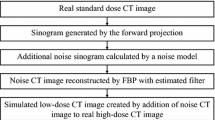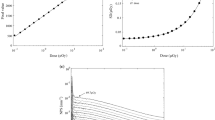Abstract
Purpose
The quality of X-ray images plays an important role in computer-assisted interventions. Although learning-based denoising techniques have been shown to be successful in improving the image quality, they often rely on pairs of associated low- and high-dose X-ray images that are usually not possible to acquire at different dose levels in a clinical scenario. Moreover, since data variation is an important requirement for learning-based methods, the use of phantom data alone may not be sufficient. A possibility to address this issue is a realistic simulation of low-dose images from their related high-dose counterparts.
Method
We introduce a novel noise simulation method based on an X-ray image formation model. The method makes use of the system parameters associated with low- and high-dose X-ray image acquisitions, such as system gain and electronic noise, to preserve the image noise characteristics of low-dose images.
Results
We have compared several corresponding regions of the associated real and simulated low-dose images—obtained from two different imaging systems—visually as well as statistically, using a two-sample Kolmogorov–Smirnov test at 5% significance. In addition to being visually similar, the hypothesis that the corresponding regions—from 80 pairs of real and simulated low-dose regions—belonging to the same distribution has been accepted in 81.43% of the cases.
Conclusion
The results suggest that the simulated low-dose images obtained using the proposed method are almost indistinguishable from real low-dose images. Since extensive calibration procedures required in previous methods can be avoided using the proposed approach, it allows an easy adaptation to different X-ray imaging systems. This in turn leads to an increased diversity of the training data for potential learning-based methods.






Similar content being viewed by others
References
Amiot C, Girard C, Chanussot J, Pescatore J, Desvignes M (2016) Spatio-temporal multiscale denoising of fluoroscopic sequence. IEEE Trans Med Imaging 35(6):1565–1574
Cerciello T, Bifulco P, Cesarelli M, Fratini A (2012) A comparison of denoising methods for X-ray fluoroscopic images. Biomed Signal Process Control 7(6):550–559
Chan CL, Sullivan BJ, Sahakian AV, Katsaggelos AK, Swiryn S, Hueter DC, Frohlich T (1990) Simulation of quantum mottle in digital angiographic images. Biomed Image Process 1245:104–111 SPIE
Chen Y, Pock T (2017) Trainable nonlinear reaction diffusion: a flexible framework for fast and effective image restoration. IEEE Trans Pattern Anal Mach Intell 39(6):1256–1272
Dabov K, Foi A, Katkovnik V, Egiazarian K (2009) BM3D image denoising with shape-adaptive principal component analysis. In: Signal processing with adaptive sparse structured representations
Gislason-Lee AJ, Kumcu A, Kengyelics SM, Brettle DS, Treadgold LA, Sivananthan M, Davies AG (2015) How much image noise can be added in cardiac x-ray imaging without loss in perceived image quality? J Electron Imaging 24(5):051006
Hariharan SG, Kaethner C, Strobel N, Kowarschik M, Fahrig R, Navab N (2018) Estimation of noise stabilization parameters for low-dose X-ray images corrupted by Poisson–Gaussian noise. (manuscript in preparation)
Hariharan SG, Strobel N, Kaethner C, Kowarschik M, Demirci S, Albarqouni S, Fahrig R, Navab N (2018) A photon recycling approach to the denoising of ultra-low dose X-ray sequences. Int J CARS 13:847–854. https://doi.org/10.1007/s11548-018-1746-2
Hariharan SG, Strobel N, Kowarschik M, Fahrig R, Navab N (2018) Simulation of realistic low dose fluoroscopic images from their high dose counterparts. In: Bildverarbeitung für die Medizin 2018, Springer, pp 80–85
Holdsworth D, Gerson R, Fenster A (1990) A time-delay integration charge-coupled device camera for slot-scanned digital radiography. Med Phys 17(5):876–886
Kostadin D, Alessandro F, Karen E (2007) Video denoising by sparse 3D transform-domain collaborative filtering. In: European signal processing conference, vol 149
Kuan DT, Sawchuk AA, Strand TC, Chavel P (1985) Adaptive noise smoothing filter for images with signal-dependent noise. IEEE Trans Pattern Anal Mach Intell 2:165–177
Luisier F, Blu T, Unser M (2007) A new sure approach to image denoising: interscale orthonormal wavelet thresholding. IEEE Trans Image Process 16(3):593–606
Makitalo M, Foi A (2013) Optimal inversion of the generalized anscombe transformation for poisson-gaussian noise. IEEE Trans Image Process 22(1):91–103
Massey FJ Jr (1951) The Kolmogorov–Smirnov test for goodness of fit. J Am Stat Assoc 46(253):68–78
Matviychuk Y, Mailhé B, Chen X, Wang Q, Kiraly A, Strobel N, Nadar M (2016) Learning a multiscale patch-based representation for image denoising in X-ray fluoroscopy. In: Proceedings of international conference on image processing, pp 2330–2334
Schmidt U, Roth S (2014) Shrinkage fields for effective image restoration. In: Proceedings of the IEEE conference on computer vision and pattern recognition, pp 2774–2781
Starck JL, Murtagh FD, Bijaoui A (1998) Image processing and data analysis: the multiscale approach. Cambridge University Press, Cambridge
Veldkamp WJ, Kroft LJ, van Delft JPA, Geleijns J (2009) A technique for simulating the effect of dose reduction on image quality in digital chest radiography. J Digit Imaging 22(2):114–125
Wolterink JM, Leiner T, Viergever MA, Isgum I (2017) Generative adversarial networks for noise reduction in low-dose CT. IEEE Trans Med Imaging 36:2536–2545
Yang K, Huang SY, Packard NJ, Boone JM (2010) Noise variance analysis using a flat panel X-ray detector: a method for additive noise assessment with application to breast ct applications. Med Phys 37(7):3527–3537
Zhang K, Zuo W, Chen Y, Meng D, Zhang L (2017) Beyond a Gaussian denoiser: residual learning of deep cnn for image denoising. IEEE Trans Image Process 26:3142–3155
Acknowledgements
This work was supported by Siemens Healthineers AG. The concepts and results presented in this paper are based on research and are not commercially available.
Author information
Authors and Affiliations
Corresponding author
Ethics declarations
Conflict of interest
The authors declare that they have no conflict of interest.
Ethical approval
This article does not contain any studies with human participants or animals performed by any of the authors.
Additional information
Publisher's Note
Springer Nature remains neutral with regard to jurisdictional claims in published maps and institutional affiliations.
Rights and permissions
About this article
Cite this article
Hariharan, S.G., Strobel, N., Kaethner, C. et al. An analytical approach for the simulation of realistic low-dose fluoroscopic images. Int J CARS 14, 601–610 (2019). https://doi.org/10.1007/s11548-019-01912-6
Received:
Accepted:
Published:
Issue Date:
DOI: https://doi.org/10.1007/s11548-019-01912-6




